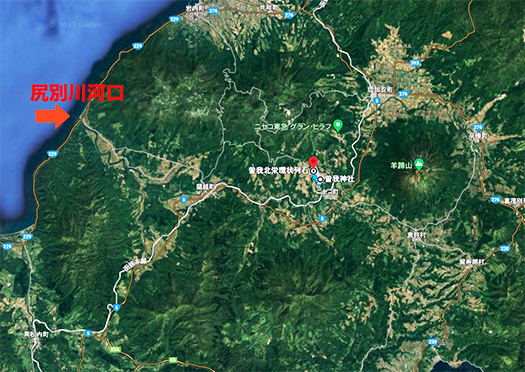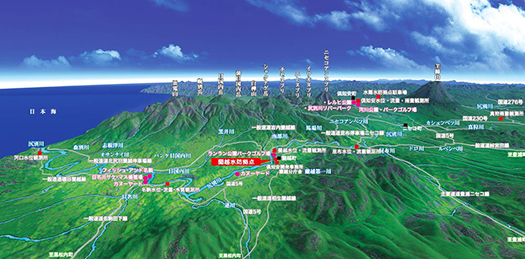


わたしは旅先とか、出張などで訪れる地域の「地史」への興味が非常に盛り上がるタイプなのか。歴史書は好きですがもちろん網羅的に読破しているわけではない。実際に訪問するとその周辺記憶領域が強く反応して「おい、おまえ、この辺のこと放置しているべや」とうごめき、ささやき返してくる。
今回ニセコ地域を遊動してみて、あらためて日本史との関係性に強く思いが至ってしまった。やはりこの地域と日本史の関係では阿倍比羅夫の北方遠征が強烈な古代史のインパクト。地名にまで比羅夫がある。
阿倍比羅夫は高志(越)国・越後の国司の地位にあって大化の改新時期の有力人物。この北方制圧の政治軍事行動からその後、翌年には古代日本の大敗戦である白村江へも出征している。当時の日本国家の「海軍力」は環日本海が主戦場。そこに特化して活動したことから、事実上の国家軍事部門統括だと推認可能。舟の大きさも不明だけれど180-200艘の軍団規模「大河のほとり」に進出したとされる。地元の族長たちはその勢威に圧倒されて恭順を申し出てきたのだという。この「大河」がさてどこであるのか、ということからして北海道地域史では確定的な論を持っていない。
阿倍比羅夫が置いたとされる「郡領」の位置を巡って多数の研究者たちが多年にわたって発掘などの調査活動を行ってきているとされている。国書に記載があるとは言え、そもそも事実としてそういった「建築的施設」があったのかどうかも不明なのだから、労多い作業だとは思う。
一介の歴史好きとしては研究者のみなさんの活動に期待しつつ、後方羊蹄という残された地域名と、大河という表記、そして大軍船団という歴史事実から推定して、写真のような光景が古代人にも同様に映じていたと考えられると思っている。
いまの河川名で言えば「尻別川」が擬定されるにふさわしい。阿倍比羅夫の遠征は、その後の白村江出征も国家的な海軍力の示威であり、実際の戦争行為でもあったことから、この北方遠征もそういったコンテキストと同様でしょう。この地域で族長層からは日本古代王権に対しての服従対応があったということ。
阿倍比羅夫は帰朝後、ヒグマの毛皮多数と,生きたヒグマ2頭を朝廷にもたらしたといわれる。この後方羊蹄地域の族長たちと「戦わずして外交的に勝利した」ということが真実なのだろう。郡領を設置したらと申し出たのは現地族長層からだったとされている。
さてそこで実際に阿倍比羅夫は羊蹄山の周辺地域まで「郡領」を設置しに向かったかどうか。現地族長たちにしてみると、たしかに大河の畔でその軍威にひれ伏したけれど、実際に自分たちのテリトリーまで軍の首領を導き入れるかどうかは疑問も残る。阿倍比羅夫としてもそこまで身の安全確保に自信を持てただろうか。興味津々の地域史探偵団であります(笑)。
English version⬇
Abenohirao’s Northern Expedition and the “Backward Yotei” Shiribetsu River
Yotei from the Shiribetsu River mouth area, and was offered submission by the local tribal leaders. Diplomatically, the expedition was a success. Whether or not they actually established “county fiefdom” building facilities? ・・・
Am I the type of person whose interest in the “local history” of an area I visit when traveling or on a business trip is very excited? I like history books, but of course I have not read them exhaustively. When I actually visit an area, my peripheral memory reacts strongly and whispers back to me, “Hey, you, you left this area out.
This time, as I traveled around the Niseko area, I was reminded of the strong relationship between the area and Japanese history. As one would expect, the relationship between this area and Japanese history is strongly influenced by the northern expedition of Abepirābu, which had a strong impact on the ancient history of Japan. Even the name of the place has Hirao in it.
Abenohirau was a powerful figure during the Taika Reform Period in his position as provincial governor of Koshi-no-Kuni and Echigo. From this politico-military action to control the northern part of the country, he later went to the Hakumura River, the great defeat of ancient Japan, in the following year. The main battlefield for the “naval power” of the Japanese nation at that time was the Japan Sea Rim. Since he specialized his activities there, it can be inferred that he was in charge of the de facto national military department. Although the size of their ships is unknown, it is said that they advanced to the “banks of the great river” with an army of 180 to 200 ships. The local chiefs were overwhelmed by the force of the army and offered their respect. The history of Hokkaido does not have a definite theory as to where this “great river” was located.
Many researchers have been excavating and investigating the location of the “county fiefdom” where Abenohirau is said to have placed it for many years. Although it is mentioned in the National Records of Japan, it is still unclear whether or not such an “architectural facility” existed in the first place, so it is a laborious task.
As a history buff, I look forward to the activities of researchers, but based on the name of the area, which remains as Yotei in the back, the description of the river, and the historical fact of a large military fleet, I believe that the ancient people would have seen the same scene as in the photo.
In today’s river names, the Shiribetsu River is an appropriate name for the area. The Abenohirao expedition would be similar to such a context, as the subsequent expedition to the Hakumura River was also a demonstration of national naval power and an actual act of war. It means that there was a submissive response to the ancient Japanese kingship from the chiefs in this region.
Abenohirau is said to have brought a large number of brown bear pelts and two live brown bears to the imperial court after his return. It is probably true that he “won a diplomatic victory without a fight” with the chiefs of this backward yotei region. It is said that it was the local chiefs who offered to establish a county fiefdom.
Now, whether or not Abepirābu actually went to the area around Yotei to establish a “county fiefdom” is not clear. The local chieftains were indeed prostrated by his military might on the banks of the great river, but it is doubtful that they would actually lead a military leader into their own territory. Would Abenohirau have been so confident of his own safety? The Local History Detective Corps is very curious (laughs).
Posted on 5月 6th, 2023 by 三木 奎吾
Filed under: 歴史探訪







コメントを投稿
「※誹謗中傷や、悪意のある書き込み、営利目的などのコメントを防ぐために、投稿された全てのコメントは一時的に保留されますのでご了承ください。」
You must be logged in to post a comment.